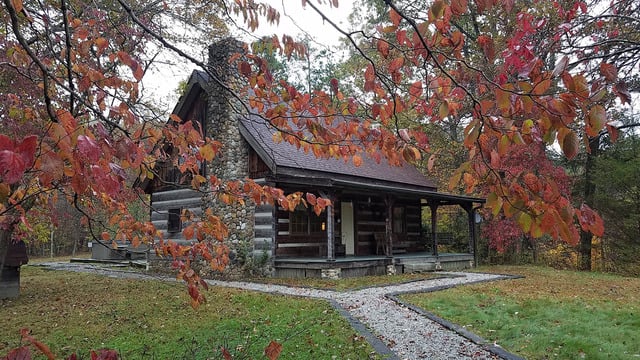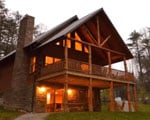MOHICAN STATE PARK
Mohican State Park and the adjacent state forest are outstanding in their beauty and offer limitless opportunities for visitors to explore one of Ohio's most unique natural regions. The striking Clearfork Gorge, hemlock forest and scenic Mohican River offer a wilderness experience while the resort lodge and cottages provide luxurious accommodations.
Park Map (pdf)The scenic beauty and natural features of the Mohican region can be attributed to events that occurred over 12,000 years ago during the ice age in Ohio. The last glacier to enter Ohio, the Wisconsinan, ended its advance in the Mohican region forming a glacial boundary. Several moraines, linear ridges of soil and rock till deposited along the ice edge, are evident in the area.
The erosional forces of glacial meltwaters hastened the carving of the narrow gorge of the Clear Fork of the Mohican River. This gorge cuts into the sandstone bedrock exposing huge outcroppings and creating steep cliff walls. The gorge is more than one thousand feet wide at the top and over three hundred feet deep. The striking Clearfork Gorge with its towering hemlocks and stands of old-growth white pine are of national significance. The National Park Service has thus dedicated the area as a Registered National Natural Landmark.
The Mohican State Memorial Forest surrounds the park and contains great plant and animal diversity. Ridge tops contain stands of white, red and black oaks, red maple and white pine. Beech, ash and tulip can be found in the middle and lower slopes with hemlock and yellow birch. The bottomlands contain sycamore, willow, buckeye, hawthorn and dogwood. The diversity of ferns in this region is astounding with as many as fifteen different species identified, including the rare walking fern.
Mohican is home to numerous mammals including raccoon, white-tail deer, skunk, opossum and red fox. Reptiles such as the box turtle, black rat snake and the poisonous copperhead are present in the area. Dusky salamanders, American toads and the gray tree frog are samples of local amphibians. The wild turkey has made a tremendous comeback in Ohio after being totally extirpated at one time. Significant numbers of this magnificent bird can be found in the surrounding forest.
Of particular interest is the abundance of nesting warblers in the Clear Fork Gorge. More than fifteen species including Northern Parula, Hooded, Cerulean and American Redstart nest here during spring and summer.
The Mohican State Park area was once the hunting grounds of the Delaware Indians, whose more famous warriors included Janacake, Bill Montour, Thomas Lyon (reportedly the ugliest man alive!) and James Smith, who was the first white man to come to this area. Smith was captured by the Indians and later adopted into their tribe. Several Delaware villages were located in the Mohican vicinity. Settlement by non-Indians began at the turn of the nineteenth century, but settlement did not increase until the Indians were driven from the area during the War of 1812. John Chapman, immortalized as Johnny Appleseed, frequented the region during the 1800's, caring for his apple tree nurseries. His name and the date, carved in the wall of Lyons Falls, were an attraction for years. Unfortunately, the etchings have been obliterated with the passage of time.
Prior to 1949, most of the area that comprises the present Mohican State Park was part of the Mohican State Forest (also known as Mohican State Forest Park). The forest lands were administered by the Ohio Division of Forestry. In 1949, when the Ohio Department of Natural Resources was created, Mohican and several other state parks were developed from existing state forests. The new park was named Clear Fork State Park. Years later in 1966, the name was changed to Mohican State Park in order to alleviate confusion between Mansfield's Clearfork Reservoir and the state park. Even before this official move, visitors referred to the area as Mohican.
Ohio does not have an annual pass and does not charge entrance fees to state parks.
GeneralLand, acres1,110
Nearby State Forest, acres5,109
Day-UseFishingyes
Huntingyes
Hiking Trail, miles13
Backpack Trailyes
Picnickingyes
Picnic Shelters, #4
Bridle Trailsyes
Nature Centeryes
Nature Programsyes
CampingPrimitive, #35
Electric Sites, #118
Full Hookup Sites, #33
Pets Permittedyes
Flush Toiletsyes
Dumpstationyes
Showersyes
Camp Commissaryyes
Camper Cabins, #2
Group Camp, capacity100
Campground Poolyes
Rent-A-Teepee, #2
Walk-In Campsites, #12
WinterSnowmobilingyes
AccommodationsLodge Rooms, #96
Family Cottages, #25
Game Roomyes
Indoor Swimming Poolyes
Tennisyes
Outdoor Swimming Poolyes
Restaurantyes
The family campground at Mohican offers 153 campsites with electricity, fire rings and picnic tables. Full service hookups are available at 33 campsites. The main campground is equipped with showers, flush toilets, dump station and a camp commissary. A second campground with 24 sites has pit latrines, tables and firerings. The group camp can accommodate organized groups of up to 100 people.
Campground Map (pdf)Twenty-five family cottages are located along the river in a wooded area. Each of the cottages will accommodate six people. The cottages are heated for year-round use and contain cooking utensils, towels, bed linens and blankets.
The lodge at Mohican offers luxurious seclusion and comfortable resort accommodations. There are 96 air-conditioned rooms, each with a private balcony and color television. The lodge is equipped with private meeting and banquet rooms for groups up to 425, a dining room, sauna, gift shop, lounge, and olympic-size indoor and outdoor pools.




